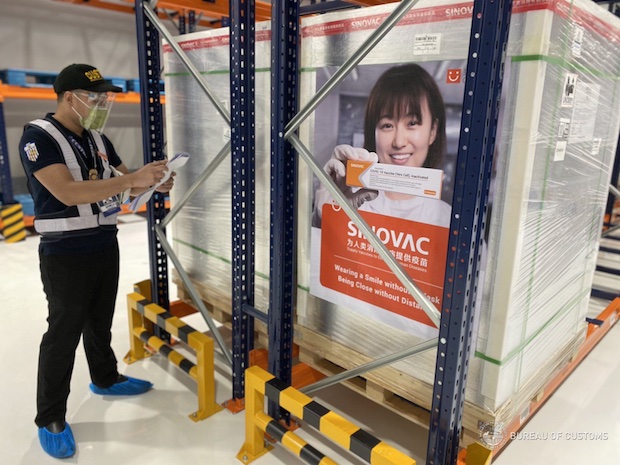BOC systems ensure efficient service delivery even during COVID-19 pandemic

A Bureau of Customs examiner at the Port of NAIA examines a shipment of CoronaVac vaccines as part of the bureau’s commitment to facilitate COVID-19 response initiatives. (Photo from the Bureau of Customs)
MANILA, Philippines — As of May 31, the Bureau of Customs has cleared more than eight million doses of vaccines — 5.5 million doses of CoronaVac, 2.556 million doses of AstraZeneca, 193,050 doses of Pfizer, and 80,000 doses of Sputnik V.
Those doses came in a total of 15 COVID-19 shipments since the first delivery last Feb. 28.
“The Bureau of Customs’ massive preparation for the expected influx of COVID-19 vaccines is its contribution to the nation’s quest against the COVID-19 pandemic and the immediate recovery of the country’s economy,” the bureau said in a recent statement outlining key achievements in its continuing program of modernization.
“In fact, prior to the influx of COVID-19 vaccine shipments, the Bureau of Customs increased its efforts in monitoring and ensuring the smooth flow of imported COVID-19 vaccines,” the statement said.
One key measure is the creation of the Covax Importation Unit, which ensures the speedy processing of COVID-19 vaccine imports. To achieve this, it coordinates with the Inter-Agency Task Force on Emerging Infectious Diseases and other relevant agencies.
Then there is the 24/7–Ready One-Stop-Shop at the Port of NAIA to ensure the prompt processing and release of approved vaccines.
According to the BOC, this proved successful at the height of the pandemic last year, as it allowed the quick and systematic release of imported personal protective equipment, medical supplies, and other goods essential in the fight against the COVID-19 pandemic.
The bureau said it achieved this while all regulated goods had the required permits.
Automation systems
Even before the pandemic, however, the BOC had already started implementing modernization projects to automate its operations, which reduced the necessity for human interactions — a source of inefficiency and even corruption.
In 2019 alone, the BOC implemented the following eight information technology systems:
1. Goods Declaration Verification System (GDVS)
This is a queue management system designed to combat red tape and promote transparency through random assignment of entries for assessment to BOC examiners and appraisers. The system also allows stakeholders to get real-time updates on the status of their goods declaration.
2. National Value Verification System (NVVS) which was upgraded to Enhanced Value Reference National Value Verification System (e-VRIS) in 2020
The e-VRIS aims to help the BOC set up a reliable and comprehensive database of information on the value and classification of imports for reference in support of the implementation of the World Trade Organization’s Valuation System.
3. Alert Order Monitoring System (AOMS)
This system tracks the status of alert orders and alerted shipments and enable the monitoring of alert status from issuance until resolution.
4. Document Tracking System (DTS)
This system tracks documents under processing in different offices of the BOC.
5. Customer Care Portal System (CCPS)
This system enables stakeholders to electronically lodge and track the status of their inquiries, requests, and concerns. It also allows online submission of applications for accreditation, which helps in effectively streamlining customs processes and limiting face-to-face transactions.
6. OCOM Dashboard System
This is an internal one-stop executive tool that provides real-time updates about BOC operations and a comprehensive view of what is happening in all ports nationwide.
7. Balikbayan Box and Parcel Tracking System
This system allows customers to track the location and status of parcels sent to them either by air or by sea.
8. Electronic Tracking of Containerized Cargo (E-TRACC)
This allows real-time monitoring of inland movements of containerized cargo using a GPS-enabled tracking device to secure transport to the intended destination.
Other system enhancements in 2019 include the procurement of a high-performance server, the upgrade of the fire eye system (a firewall), and the implementation of the e2m Stabilization Plan.
‘No contact policy’
During the first semester of 2020, the bureau lined up programs to introduce new systems and to fully implement a “no contact policy” to lessen opportunities for corruption. This policy has also proven useful in preventing the spread of the coronavirus.
In February 2020, the BOC also inaugurated its first Customer Care Center (CCC), which has been replicated by all ports nationwide.
These centers continue to serve as one-stop-shop for services such as centralized document receiving and releasing. They also have interactive. information kiosks.
According to the BOC, clients and other stakeholders are now using the online systems in processing documents while the physical submission of such documents is being regulated.
The Anti-Red Tape Authority (ARTA) has lauded the BOC for being one of the first agencies to comply with its requirement to produce a Citizen’s Charter handbook.
In June 2020, the BOC signed an agreement to set up an online payment with the Bureau of the Treasury, the Development Bank of the Philippines, and PayMaya Philippines Inc.
These systems aim to improve ease of doing business in the BOC by reducing face-to-face transactions without compromising its quality service.